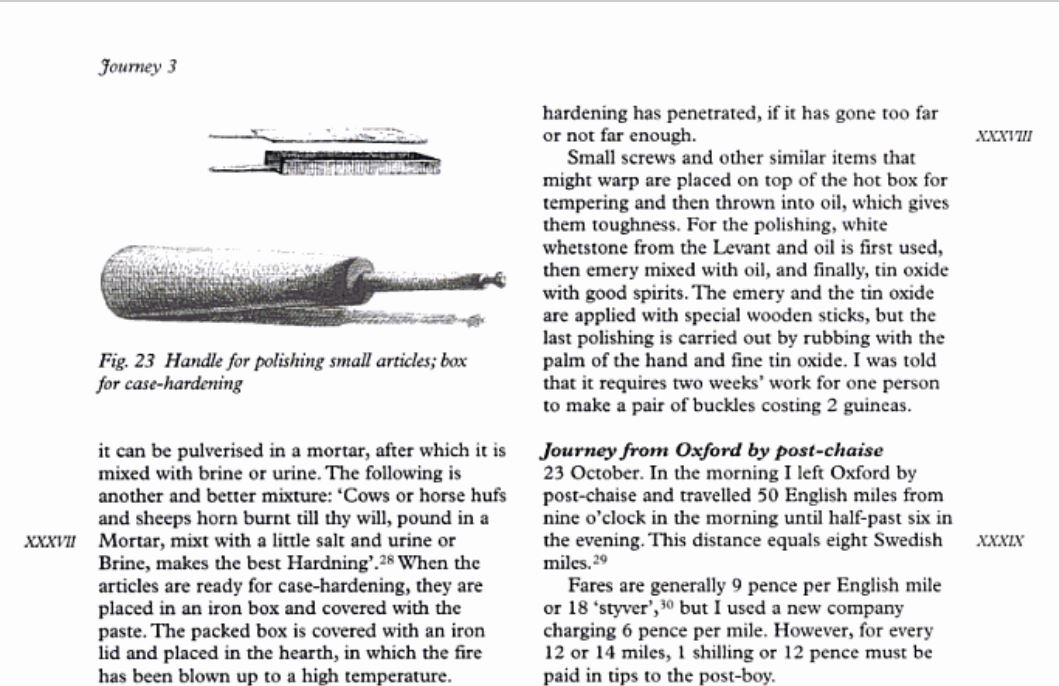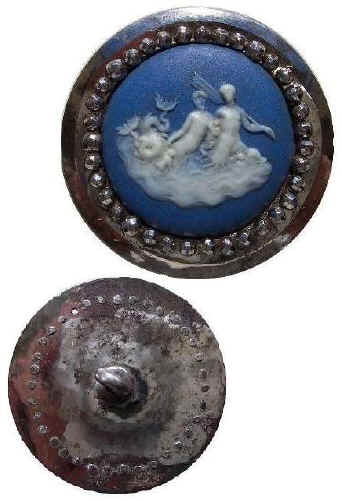|
| |
Antique Regency fully fitted rosewood sewing box with cut steel decoration Circa 1810
Please click on images to enlarge | thumbnail index |
high resolution
|
Description:
Ref: 697SB
http://hygra.com/box/697SB-cut-steel
Antique Regency shaped fully fitted rosewood sewing box the outside
decorated with diamond faceted steel work decoration. The inside
is finished in blue paper and silk. The lid is lined with ruched silk
framed by a plain border. There is a document wallet behind. The compartmentalized
lift out tray has four supplementary lids covered in
brocaded silk with decorative pulls. The edges and partitions
are accented with cast pewter bead work. The box has
original period steel and embossed and chased
silver sewing tools. These include scissors with sheath,
stiletto, a combined wax-spoon and tweezers, a pin cushion in the form
of a wicker basket tape-measure and thimble. Circa 1810.
Origin: UK ; Circa:
1810 ; Materials: .
Size: 28 cm wide by 20 cm by 14 cm: 11
inches wide
by 7.9 inches by 5.5 inches.
Condition: good
original overall; working lock and key; see images
Keywords: Regency, sewing
box, silk, rosewood, cut steel, Woodstock, faceted steel, Reinhold
Rucker Angerstein, Torston Berg, hygra, hygra.com
Request
current list of available sewing boxes with prices.
Request
current list of available writing boxes with prices.
Request
current list of available jewelry boxes with prices.
Request
current list of available tea caddies with prices.
boxes@hygra.com
|
 (Small).JPG)
|

 (Small).JPG)
Many features such as the rectangular holes in the lock plated
point to this box having made in the UK. During the 18th and early 19th
C the faceted steel nails were exported to France and employed by the
Palais Royal makers: see: http://hygra.com/uk/jb2/jb174/
|
The nails used in the
decoration each have facets cut into their heads. The handle too is of
cut steel.
|
Today few
have heard of the
remarkable 18th century polished steelwork for which Woodstock was once
famous. It was reputedly made from
horseshoe nails reworked to make delicate faceted studs, cut like
diamonds and highly polished they were used to decorate watch chains, buckles,
scissors, buttons, and other items. Cut-steel short swords were particularly
sought after. Sold locally, but also in London its international reputation was
spread by fashionable tourists visiting Blenheim Palace.
In 1742 Horace Walpole
sent Woodstock steel wares to the British Consul in Florence requesting that
they be given as diplomatic gifts. In 1759 buckles were ordered for the King of
Prussia and in 1768 the King of Denmark, on a visit to Blenheim, also bought
steel. The early 18th century origins of the industry are obscure and within
less than a hundred years it had disappeared entirely in the face of competition
from the Birmingham manufacturers.
see: http://www.bbc.co.uk/ahistoryoftheworld/objects/Ic0jSRG8QaOBdTDQCaxEIw

|
|
Please click on images to enlarge | slide show | thumbnail index |
 (Small).JPG)
|
One of the best accounts I have found of steel working is by Reinhold Rucker
Angerstein. He seems have been an eighteenth-century industrial spy. He
recorded his findings and detailed observations in illustrated diaries and
notebooks. A translation of the Diary by Torston Berg and completed
his son, Peter was published by the National Museum of Science & Industry in
2001 ISBN
1 900747243.
There is a preview of the book at: Google
Books.
Each nail was held in a sort of pin vice and the facets were cut in.
" For the polishing, white whetstone from the Levant and oil
is first used then emery mixed with oil, and finally, tin oxide with
good spirits. The emery and tin oxide are applied with special wooden
sticks, but the last polishing is carried out by rubbing with the palm
of the hand and fine tin oxide.
"I was told that it requires two weeks' work for one person to
make a pair of buckles costing 2 guineas."

|
There are examples of cut steel jewelry at: http://www.historywebsite.co.uk/Museum/metalware/steel/steel2.htm
Although difficult and time consuming to work cut steel work
had the advantage that the raw material was comparatively inexpensive.
The carrying handle is both wrought and cut. The pillars are turned
and faceted. Even the plate has its edges carefully cut. The steel
is all polished and case hardened. It would have been easier to work the
steel while soft. Steel is softened by allowing it to cool slowly.
|
 (Small).JPG)
|
Please click on images to enlarge | slide show | thumbnail index |
The use of steel as a medium of applied art was
developed in Tula , in Russia , which already had a long tradition of
metalworking, mainly for armory. Under the auspices of Catherine II,
steel became a medium for fashioning both domestic and personal
ornaments. In sewing it was used both for chatelaines and tools. The
diamond faceted, jewel like steel pins were adopted by French workers
for the fine Palais Royal boxes and to a lesser extent for other boxes.
This form of decoration was sparingly adopted in
England , although, ironically, the steel heads were exported to France
from the Northern English towns of Wolverhampton and Birmingham and from
Woodstock in Oxfordshire. Perhaps it was the expressed realization of
how much an old nail was worth once it was converted into a cut steel
ornament, which put off the English; they preferred to sell their old
nails to the French.
|
 (Small).JPG)
|
Please click on images to enlarge | slide show | thumbnail index |
 (Small).JPG)
|
There are examples of cut steel jewelry at: http://www.historywebsite.co.uk/Museum/metalware/steel/steel2.htm
Although difficult and time consuming to work cut steel work
had the advantage that the raw material was comparatively inexpensive.
The carrying handle is both wrought and cut. The pillars are turned
and faceted. Even the plate has its edges carefully cut. The steel
is all polished and case hardened. It would have been easier to work the
steel while soft. Steel is softened by allowing it to cool slowly.
|
Please click on images to enlarge | slide show | thumbnail index |
 (Small).JPG)
|
The nails sparkle.
|

Photo courtesy: http://upload.wikimedia.org/wikipedia/
commons/9/9a/Merfamily_wedgewood_cut_steel_f&b_semivertical.jpg
|
Mathew
Boulton (1728-1809) made cut
steel mounts for Wedgewood's blue and white jasperware buttons in the
1760s.
It is interesting to note that the polished
steel nails were riveted into the back plate. This is time consuming
work. But it was a high price market from relatively inexpensive
ingredients. The "art" was in the craftsmanship.
Boulton's partnership with James Watt manufactured
hundreds of steam engines which contributed to the Industrial Revolution.
His father is recorded as having been a
manufacturer of small metal products in Birmingham.
|
The inside is finished in blue paper and silk. The lid is lined with
ruched silk framed by a plain border. There is a document wallet
behind. The compartmentalized lift out tray has four
supplementary lids covered in brocaded silk with decorative pulls.
The edges and partitions are accented with cast pewter bead work.
|
 (Small).JPG)
|
Please click on images to enlarge | slide show | thumbnail index |
 (Small).JPG)
|
Under the lift-out tray the box is lined with its original blue
paper.
|
 (Small).JPG)
|
The compartmentalized lift out tray has four
supplementary lids covered in brocaded silk with decorative pulls.
The edges and partitions are accented with cast pewter bead work.
The box has original period steel and embossed and
chased silver sewing tools. These include scissors with
sheath, stiletto, a combined wax-spoon and tweezers, a pin cushion in
the form of a wicker basket tape-measure and thimble.
|
Please click on images to enlarge | slide show | thumbnail index |
The tools include scissors with sheath, stiletto, a
combined wax-spoon and tweezers.
|
 (Small).JPG)
|
Please click on images to enlarge | slide show | thumbnail index |
 (Small).JPG)
|
The pincushion in the form of a basket is decorated with chased
embossing.
|
The supplementary lids have unmarked cast white metal pulls.
These are probably silver.
|
 (Small).JPG)
|
The underside of the pincushion is embossed with the pattern of a wicker
basket.
The tape measure retains its original tape.
|
 (Small).JPG)
|
Please click on images to enlarge | slide show | thumbnail index |
 (Small).JPG)
|
Under the lids there are compartments for thread reels.
|
 (Small).JPG)
|
The underside is still decorated with its original paper.
The box stands on turned rosewood feet.
|
Please click on images to enlarge | slide show | thumbnail index |
All text and images and linked images are ©
1999-2013 Antigone Clarke and Joseph O'Kelly. If you require any further
information on permitted use, or a licence to republish any material, email us
at copyright@hygra.com
|
